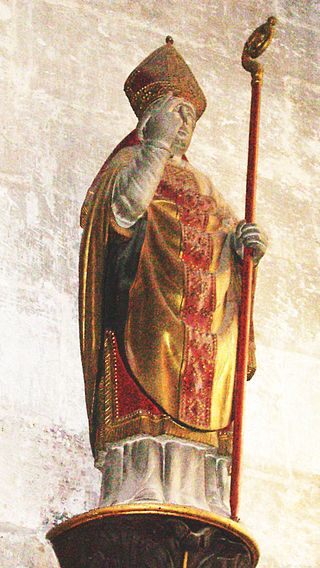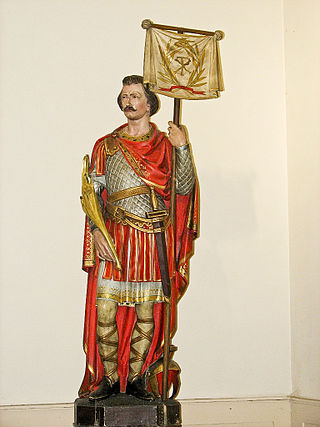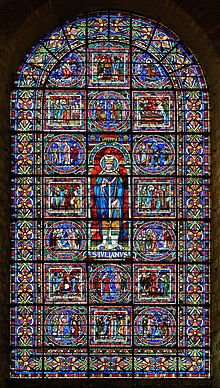
Denis of Paris was a 3rd-century Christian martyr and saint. According to his hagiographies, he was bishop of Paris in the third century and, together with his companions Rusticus and Eleutherius, was martyred for his faith by decapitation. Some accounts placed this during Domitian's persecution and incorrectly identified St Denis of Paris with the Areopagite who was converted by Paul the Apostle and who served as the first bishop of Athens. Assuming Denis's historicity, it is now considered more likely that he suffered under the persecution of the emperor Decius shortly after AD 250.

Martial, called "the Apostle of the Gauls" or "the Apostle of Aquitaine", was the first bishop of Limoges. His feast day is 30 June.

Fermin was a legendary holy man and martyr, traditionally venerated as the co-patron saint of Navarre, Spain. His death may be associated with either the Decian persecution (250) or Diocletianic Persecution (303).

September 30 - Eastern Orthodox liturgical calendar - October 2

April 29 - Eastern Orthodox liturgical calendar - May 1

May 1 - Eastern Orthodox Church calendar - May 3

John of Shanghai and San Francisco was a prominent Eastern Orthodox ascetic and hierarch of the Russian Orthodox Church Outside Russia (ROCOR) who was active in the mid-20th century. He was a pastor and spiritual father of high reputation and a reputed wonderworker to whom were attributed powers of prophecy, clairvoyance and healing. He is often referred to as "St. John the Wonderworker".

July 12 – Eastern Orthodox Church calendar - July 14

Apollinaris of Ravenna is a Syrian saint, whom the Roman Martyrology describes as "a bishop who, according to tradition, while spreading among the nations the unsearchable riches of Christ, led his flock as a good shepherd and honoured the Church of Classis near Ravenna by a glorious martyrdom."

January 6 - Eastern Orthodox liturgical calendar - January 8

Liborius of Le Mans was the second Bishop of Le Mans. He is the patron saint of the cathedral and archdiocese of Paderborn in Germany. The year of his birth is unknown; he died in 397, reputedly on 23 July.

Saint Lucian of Beauvais is a Christian martyr of the Catholic Church, called the "Apostle of Beauvais." He was killed in the 3rd century during the Diocletian persecution, although later traditions make him a martyr of the 1st century instead. This was because the church of Beauvais attempted to claim apostolic origins for itself. Odo, bishop of Beauvais during the 9th century, was the first writer to designate Lucien as the first bishop of Beauvais.

Saint Mansuetus was the first Bishop of Toul.

Nicasius of Die was a 4th-century bishop from Gaul, present-day France. As Bishop of Die he is notable to history as one of only five Catholic bishops from the Western part of the Roman Empire who attended the First Council of Nicaea in 325.

Saint Maximus of Évreux, called Saint Mauxe locally, is venerated as a saint by the Catholic Church and the Eastern Orthodox Church. His legend states that he was the second bishop of Évreux, and that he died a martyr at Acquigny with his brother, who was his deacon. His brother is called Venerandus (Vénérand) or Victorinus.

Saint Julian of Brioude (†304) was a legendary martyr and saint from the Auvergne region of France. Although the main focus of his cultus was in the small village of Brioude, he was originally from the city of Vienne, and also associated with Clermont. He was most famous through his association with an aristocratic family of bishops of the time, his most notable proponents being St. Gallus of Clermont and St. Gregory of Tours. Gregory wrote a vita of Julian, but his attempts to expand the saint's cult from the Auvergne to Touraine and Aquitaine were unsuccessful, and Julian is now only remembered through his basilica in the town of Brioude itself.

Stephen is traditionally venerated as the protomartyr or first martyr of Christianity. According to the Acts of the Apostles, he was a deacon in the early Church at Jerusalem who angered members of various synagogues by his teachings. Accused of blasphemy at his trial, he made a speech denouncing the Jewish authorities who were sitting in judgment on him and was then stoned to death. Saul of Tarsus, later known as Paul, a Pharisee and Roman citizen who would later become a Christian apostle, participated in Stephen's martyrdom.

Saint Sanctinus of Meaux was a Gallo-Roman bishop and missionary, traditionally named as the first bishop of Meaux and also of Verdun.
Hilarinus was a martyr who died with Donatus of Arezzo during the persecutions of the Roman Emperor Julian. His feast day is 16 July.

Serenidus of Saulges was a 7th-century Italian Benedictine monk. His feast day is celebrated on May 7, with his brother Serenicus, or locally on August 16.















